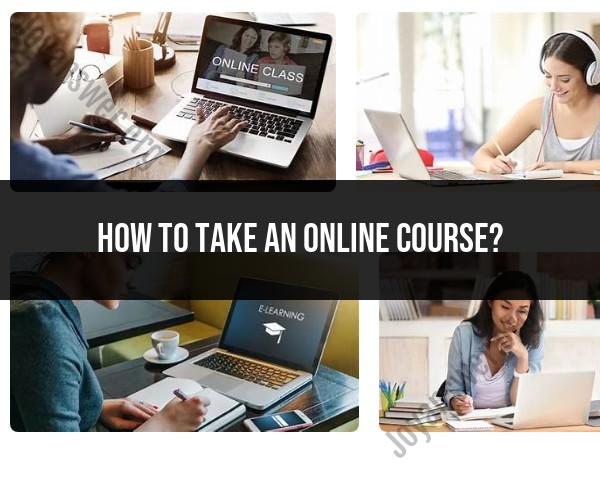How to take an online course?
Taking an online course involves a series of steps from enrollment to completion. Here's a general guide on how to take an online course:
1. Selecting a Course:
Choose a Platform:
- Identify the online learning platform where the course is hosted. Common platforms include Coursera, edX, Udacity, Khan Academy, and many others.
Browse Course Catalog:
- Explore the course catalog to find a course that matches your interests or learning goals.
Check Prerequisites:
- Ensure you meet any prerequisites for the course, such as required skills or prior knowledge.
2. Enrolling in the Course:
Create an Account:
- Sign up for an account on the chosen online learning platform if you don't already have one.
Enroll in the Course:
- Navigate to the course page and click on the "Enroll" or "Join" button. Some courses may be free, while others may require payment.
Payment (If Applicable):
- If the course is not free, proceed with the payment process, providing necessary billing information.
3. Accessing Course Materials:
Course Dashboard:
- Upon enrollment, access the course dashboard. This is where you'll find all the materials and resources for the course.
Lectures and Readings:
- Start with the introductory materials, lectures, or readings provided by the instructor.
Download Course Materials (If Necessary):
- Some courses allow you to download materials for offline access. Check if this option is available.
4. Participating in Discussions:
Discussion Forums:
- Engage with the course community through discussion forums or online communities if available.
Ask Questions:
- If you have questions about the course content, don't hesitate to ask the instructor or fellow learners.
5. Completing Assignments and Assessments:
Homework/Assignments:
- Complete any assignments or homework given by the instructor.
Quizzes and Exams:
- Take quizzes or exams as required by the course. Some courses may have graded assessments.
6. Progress Tracking:
Monitor Progress:
- Keep track of your progress through the course. Most platforms provide progress tracking features.
Completion Tracking:
- Check the criteria for completing the course, such as completing a certain percentage of lectures or passing assessments.
7. Certificates (If Offered):
Certificate of Completion:
- If the course offers a certificate of completion, review the requirements for obtaining it.
Download or Share Certificate:
- Download or share your certificate upon successful completion of the course.
8. Feedback and Reviews:
Provide Feedback:
- Provide feedback on the course and instructor. Many platforms appreciate learner feedback for improvement.
Leave Reviews:
- Consider leaving a review or rating the course to help other learners make informed decisions.
9. Continuing Education (Optional):
- Explore Other Courses:
- If you enjoyed the course, explore other courses on the platform or similar platforms to continue your learning journey.
Remember that the specific steps may vary depending on the online learning platform and the course itself. Always refer to the platform's guidelines and the course syllabus for the most accurate and relevant information.
What steps are involved in taking an online course?
Taking an online course can be a rewarding and enriching experience, offering flexibility and accessibility to learning. Here are the steps typically involved:
1. Research and Choose a Course:
- Identify your learning goals and interests.
- Research online course providers and compare their offerings.
- Read course descriptions, reviews, and instructor profiles.
- Consider factors like cost, accreditation, schedule, and learning format.
2. Enroll and Register:
- Follow the registration process on the chosen platform.
- Provide necessary information and payment details.
- Confirm enrollment and access course materials.
3. Set Up Your Learning Environment:
- Ensure you have the necessary technology and software required for the course.
- Create a dedicated study space free from distractions.
- Organize your time and schedule study sessions.
4. Engage with the Course Material:
- Review assigned readings, watch lectures, and complete online activities.
- Participate in discussions, forums, and online communities.
- Take notes and organize your learning materials.
5. Complete Assignments and Assessments:
- Submit assignments on time and meet deadlines.
- Prepare for quizzes and exams effectively.
- Utilize resources and support offered by the instructor or platform.
6. Stay Motivated and Engaged:
- Set realistic goals and track your progress.
- Connect with classmates and build a learning network.
- Seek help and clarification when needed.
- Reward yourself for completing milestones.
7. Evaluate and Reflect:
- Take time to reflect on your learning experience.
- Assess your progress and identify areas for improvement.
- Utilize your newly acquired knowledge and skills.
Additional Tips:
- Communicate effectively with your instructor and classmates.
- Develop strong time management and organizational skills.
- Seek feedback and actively participate in the learning process.
- Be patient and persistent, and don't be afraid to ask for help.
By following these steps and adapting them to your individual needs and learning style, you can maximize your success in taking online courses and achieve your learning goals.













